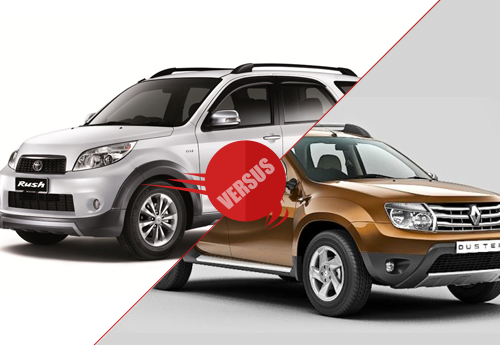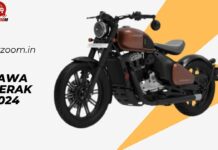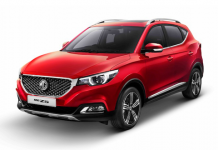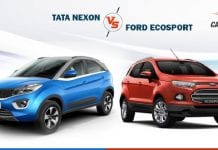
Ever since we got news that Toyota would introduce the new SUV Rush in India, we are quite assure that SUV market is in for a major change. Though, the competition would not be easy for this SUV, as there are already other SUVs in its segment which are ruling among the Indians. Renault Duster is on the top in this competitor’s list.
Set your eyes to the Duster and you are bound to hooked. Yes…look is that top most quality of this royal SUV which attracts car lovers to it. Now it would be interesting to see what changes can the Toyota’s new Rush bring in SUV market (in same segment).
Here is the brief description of both the royal SUVs.
Price:
While the Duster has the price tag of 7.99 to 12.18 lakhs, the Rush’s tentative price is 8.6-9.5 lakhs. Undoubtedly, Rush seems more affordable here in terms of price.
Brand Value:
Both the brands are well settled in the Indian car market but its obvious that Toyota is much older as well as trustable than Renault. But we can’t ignore the success of Renault in India too, its new but have managed to stay well in market.
Engine Details:
It is rumored that the yet to be launched Rush will come only in petrol variant in three various trims i.e. Rush 1.5G MT, Rush 1.5G AT and Rush 1.5S AT. On the contrary, the trendy Duster offers both variants; diesel as well petrol. While the petrol variant has two trims- petrol RxE and petrol RxL, the diesel version has diesel RxE, diesel RxL, diesel RxZ.
Renault’s SUV is equipped with 1598cc, 1.6 K4M, 4-cylinder In-line (petrol) and 1461cc, 1.5 dCi K9K HP (diesel) along with 5-speed manual transmission gearbox, though 6-speed manual transmission is also available in its some variants. And Toyota’s SUV has 1495cc, In-line 4-cylinder DOHC engine designed by using VVT-I technology.
Moving forward to the given power and torque, while Duster (petrol version) churns out the max power and torque of 102.6bhp@5850rpm & 145Nm@3750rpm respectively, Rush provides healthy power of 108bhp@6000rpm and peak torque of 141Nm@ 4400rpm. On the contrary, Duster’s diesel version churns out the power of 83.8bhp@3750rpm and 200Nm@1900rpm of torque.
The ARAI certified mileage of Rush is said to be 14.8kmpl, and Duster’ is 13.24kmpl (petrol). While, the mileage in diesel version of Duster is 20.45kmpl (ARAI certified).
Both the SUVs share the equal minimum turning radius of 5.2m and fuel tank capacity of 50 liters.
Space:
In terms of dimension, Rush seems to be smaller than the other SUV in length and width (as reported till now). While the Rush is expected to be of 4005mm in length, 1695 in width, 1705 in height and ground clearance of 200mm, the Duster has overall dimension of4315mm*1822mm*1695mm, and 205mm of ground clearance.
Duster has everything nice except its less seating capacity of just five passengers. On the other hand, Rush is following its brand’s SUVs tradition by providing the seven seating capacity.
Interiors:
At inside, it is reported till now that all the essential features like electric power steering with tilt function, AC vents, audio controls on this electric steering wheel, central locking, power windows with driver side Auto-down, audio system along with the speakers etc. are available in this Toyota’s SUV, and so as in Renault’s Duster.
While the list of other premium features is still unrevealed in upcoming Rush, the Duster has all the luxury features in it but it depends upon the variant selection i.e. top end variant costs more and offers more. A well appointed interior including seat fabric upholstery, gear knob with chrome finishing, power windows with illuminated switches, foldable rear seat backrest,12V accessory socket (front only), headlight alarm, front seat back pocket, 2 cup holders,bottle holder on console, passenger vanity mirror, trunk room lamp etc increases the glimpse of this trendy SUV.
Exterior:
At outside, Duster seems to have clean muscular lines, large headlights, a big grille with three horizontal chrome slats, protruding wheel arches both front and back, large wheels, fine shut lines which makes this SUV fit for urban environment.
On the contrary, Rush is said to be launched with new and improved look in comparison to its older sister Innova. It is said that comparatively Rush’s dimension is being reduced which will make this SUV more comfortable even on city roads.
According to a report by Toyota company, Rush will have all the outer luxury features includingmulti-reflector headlamps, projector headlamps, wing mirror, reverse sensor etc. Also the fog lamps and turn indicators are only embellished in its 1.5S AT version.
On the other side, Duster also has double barrel headlights, two-toned colored bumpers, front grille with chrome surrounding, stylish roof rails, stylish steel wheel etc which makes it sporty as well as trendy from outside.
Road handling & Safety:
Both the SUVs are well embellished with disc brakes system at front and drum brakes at rearwhich supports in providing the balanced as well as comfortable ride. But we can’t ignore the noticeable fact that Duster’s diesel version has reduced turbo lag i.e. below 2000rpm, which somehow can affect the drivability.
While the petrol Duster accelerates from 0-100 km/h in 11.8 seconds, the Rush takes 11.5 seconds (as updated till now) for the same, difference is minor here. The top speed of Duster is 164km/h and 170km/h is of Rush.
Car Zoom’s take:
Renault Duster Pros:
- Options available in engine variants i.e. both diesel as well petrol engine.
Renault Duster Cons:
- Average seating capacity just for five.
- After-sale services is not trustable.
Toyota Rush Pros:
- Comparatively less price.
- Wonderful after-sale services.
- Dimension wise smaller than other, still comparatively more seating capacity.
Toyota Rush Cons:
- Offers only petrol variant engine.




























